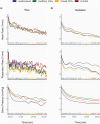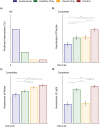Investigating the role of auditory and visual sensory inputs for inducing relaxation during virtual reality stimulation
- PMID: 36224289
- PMCID: PMC9560033
- DOI: 10.1038/s41598-022-21575-9
Investigating the role of auditory and visual sensory inputs for inducing relaxation during virtual reality stimulation
Abstract
Stress is a part of everyday life which can be counteracted by evoking the relaxation response via nature scenes presented using immersive virtual reality (VR). The aim of this study was to determine which sensory aspect of immersive VR intervention is responsible for the greatest relaxation response. We compared four conditions: auditory and visual combined (audiovisual), auditory only, visual only, and no artificial sensory input. Physiological changes in heart rate, respiration rate, and blood pressure were recorded, while participants reported their preferred condition and awareness of people, noise, and light in the real-world. Over the duration of the stimulation, participants had the lowest heart rate during the audiovisual and visual only conditions. They had the steadiest decrease in respiration rate and the lowest blood pressure during the audiovisual condition, compared to the other conditions, indicating the greatest relaxation. Moreover, ratings of awareness indicated that participants reported being less aware of their surroundings (i.e., people, noise, light, real environment) during the audiovisual condition versus the other conditions (p < 0.001), with a preference for audiovisual inputs. Overall, the use of audiovisual VR stimulation is more effective at inducing a relaxation response compared to no artificial sensory inputs, or the independent inputs.
© 2022. The Author(s).
Conflict of interest statement
The authors declare no competing interests.
Figures



References
-
- Health care, mass shootings, 2020 presidential election causing Americans significant stress, new Stress in America™ Survey finds. Accessed 16 Apr 2021. https://www.apa.org/news/press/releases/2019/11/americans-significant-st... (2019).
-
- Selye H. The Stress of Life. McGraw-Hill Book Company; 1956.

